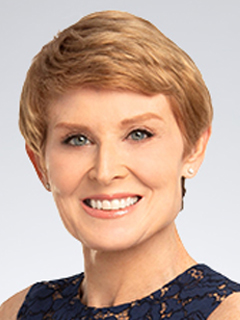Wars of the Roses: Structural change watchlist
AI will eventually help to mitigate inflationary shocks by boosting productivity growth.

July 2025
The late medieval Wars of the Roses (1455-1487) exemplified how political conflict could fracture even the closest of familial bonds. The struggle wasn’t just about succession to the English throne; it was about competitive claims to legitimate rule.
English nobility split along bloodlines that had been united for generations. Brothers fought on opposite sides, cousins became mortal foes and marriages that once cemented political alliances became sources of suspicion and betrayal.
Each side believed its cause was not just correct but divinely ordained. That made compromise nearly impossible and led to fighting that lasted for more than three decades.
The name itself, “Wars of the Roses,” did not come until later. The era was not defined by one war but by a series of civil wars among the two houses of nobility – the houses of Lancaster and York. Lancaster used a red rose as its symbol; the House of York used a white rose.
That seemed an apt place to start when looking at structural shifts underway. Political divisions are deepening within and across borders. Families have broken apart, friendships have fizzled and marriages have ended. Ties with our closest allies and trading partners are fraying. The economic integration and cooperation that defined much of the post-WWII era are being challenged.
Economists observe two forms of change:
- Cyclical changes occur rapidly and play out over the course of months or quarters. An example is the front-running of imports earlier this year prior to tariffs taking effect. Many stockpiled and bought ahead of tariffs to blunt the initial blow to profit margins. Those inventories will need to be drained; that will place a drag on growth in the second half of 2025.
- Structural changes take longer to take root and play out. Backlash to free trade is nothing new. I came of age in the Detroit area. My father made my first boyfriend park his used Honda blocks from his home, so his neighbors would not mistake it for his. Tariffs and quotas are symptoms of those tensions, and are accelerating the fragmentation that started in earnest with the president’s first term in office.
Structural shifts are inherently easier to identify as they have already occurred. They are more powerful than cyclical shifts, as they determine the length and duration of any given business cycle. An example is the unsustainable surge in debt and the financial crisis it triggered, once the housing bubble burst.
The administration’s agenda has turbocharged many trends, further fraying nerves and relationships. That is creating friction that adds to costs via higher inflation and interest rates while stemming growth. The only major offset is recent advancements in AI, which will fuel productivity growth; the problem is that those offsets are back-loaded. There is a lag between investing and scaling an innovation.
A top 10 list
1. Income and wealth inequalities worsen. The Congressional Budget Office (CBO) estimated the economic effects of the One Big Beautiful Bill Act (OBBBA) by income strata. Benefits accrue to high-income households at the expense of low-income households between 2026 and 2034. (See Charts 1 and 2.)
Tariffs amplify the regressive nature of those shifts by acting like a sales tax. They raise the price of inputs and final goods, which boosts costs. Some are passed onto the consumer in the form of higher prices, while others squeeze profit margins.
Protected industries see some job gains but not enough to offset the blow to unprotected industries. Higher input costs prompt layoffs, which hit workers harder than the owners of capital. Advancements on AI could accelerate those trends, although the most dystopian forecasts are likely an exaggeration. (See below.)
Why do we care? Inequality can create a vicious cycle in which economic resources are not deployed where returns are greatest. More affluent households have a lower propensity to spend than low- and middle-income households, which dampens aggregate demand. It limits access to education, healthcare and other resources, which curbs productivity.
Wealthy households tend to chase returns in riskier assets, which can fuel bubbles, while low- and middle-income households take on unsustainable levels of debt. The result is destabilizing; the subprime crisis and subsequent bursting of the housing market bubble is one such example.
Charts 1 and 2
2. Geopolitical tensions and economic fragmentation worsen. Russia’s invasion of Ukraine, ongoing tensions in the Middle East, China’s military ambitions and efforts to reshape the US role in the global economy are fueling geopolitical tensions. (See Chart 3.) Bilateral trade agreements are replacing regional and multilateral agreements, which is further fraying our trading relationships.
Tariffs and the trade wars they trigger are further straining international relations.. The effective tariff rate could hit 21.5%, its highest level since 1909, if the current tariff threats are enacted on August 1. That is up from below 3% at the start of the year.
A full decoupling from our largest trading partners is a long shot but cannot be ruled out. The president has argued that he would like to eliminate trade deficits entirely. That has left many of our closest trading partners seeking to form alliances with each other instead of the US, which will leave us even more isolated and susceptible to external shocks.
Chart 3: Geopolitical risk index elevated and rising
Monthly, NSA, 1985-2019=100
3. Curbs in immigration amplify the drag on economic growth due to aging demographics. The aging of the baby boom generation into retirement and low birth rates are slowing labor force growth while boosting federal outlays on Social Security and Medicare. The net result is slower potential economic growth, with larger federal debt burdens.
Foreign-born workers often fill jobs that native-born will not, while boosting federal tax revenues. The overwhelming majority of immigrant workers pays into Social Security and Medicare but is precluded from tapping those benefits.
High profile deportations, raids and rising hurdles to legal immigration are reversing immigration trends. Immigration to the US could even decline in 2025. This is creating pockets of labor shortages, with spillover effects on native-born workers.
Women with children under five years of age are dropping out of the labor force across educational attainment to care for their children. That is adding to the upward pressure on inflation in the care economy, which is outstripping overall inflation by more than twofold.
4. Government debt balloons. The CBO estimates OBBBA will add over $4 trillion to federal debt by 2034. Those increases are driven by tax cuts, increased spending on retirees and higher interest expenses. The estimates do not account for the loss in tax revenues due to fewer immigrant workers or the shortfall in tax collections by the Internal Revenue Service (IRS).
Increased funding for IRS staffing and enforcement is one of the few categories of spending that the CBO estimates will more than pay for itself. That is due to what is known as the “tax gap” or the hole between taxes that are owed and those that are paid.
The IRS estimates that gap widened to close to $700 billion in 2022, which would have gone a long way in eliminating the federal deficit that year alone. The majority of that shortfall was due to tax evasion by wealthy households and corporations.
5. Extreme weather events are growing more costly. Chart 4 shows the rise in billion-dollar weather events since 1980, after adjusting for inflation. The frequency and costs associated with extreme weather events have increased dramatically.
The administration has discontinued tracking that data. Farmers, a major constituency for the president, have petitioned for it to be restored, given the threats posed to crops and livestock. Thus far, they have failed.
Estimates by the Environmental Protection Agency suggests that agriculture, our access to water and energy grids are among the most susceptible to weather-related damages. Negative health consequences and property losses due to unusually bad weather and adverse climate conditions tend to hit low-income households more than affluent communities. They often live in areas that are cheaper due to their exposure to such events.
Those losses are in addition to disruptions to supply chains, higher insurance costs and the devasting loss of property and lives. One major storm can add weeks to a ship’s route, while the damage to property boosts insurance costs.
Those are in addition to the higher costs of repairs and rebuilding due to tariffs and curbs on immigration. Rebuilding in the wake of the fires in Los Angeles has been stunted by immigration raids on construction sites.
Chart 4: Highly destructive extreme weather events still increasing
Annual
6. Supply chains are disrupted. Tariffs are forcing firms to rethink where and with whom they do business. Uncertainty over where tariffs will land is delaying those decisions.
The administration would clearly prefer suppliers to move back onshore. That takes time and is not economically feasible for much of what we produce. There were still more than 400,000 unfilled manufacturing jobs in May, nearly 50,000 more than in 2019.
Retaliation is another consideration. Farmers were among the hardest hit by retaliation in the 2018-19 trade war. Multinational companies will be targets as well.
Waivers by the president were granted to ease the pain of tariffs during the 2018-19 trade war. Research on those waivers reveals they were allocated via petitioners’ political ties.
The least protected firms lobbied for tariffs of their own. The goal was to reduce competition so that they might more easily pass along the costs of tariffs to consumers. The phenomena is known as “cascading protectionism,” and underscores how rapidly trade tensions can escalate.
7. Technological innovation accelerates. Private sector investment in the infrastructure needed to scale AI models is rising as a share of GDP, while adoption rates are accelerating. Business usage of AI more than doubled between the Fall of 2023 and the Spring of 2025; projected AI usage is expected to nearly double. (See Charts 5 and 6.)
The lag between large technology investments and when they show up in overall productivity measures can be substantial. Most economists expect those lags to shorten with advancements in AI, given the ubiquitous role smartphones and computers play in our lives.
How much will it boost productivity growth? Initial estimates topped 7% over ten years, which would be unprecedented. Nobel Laureate economist Daron Acemoglu recently found those gains could come in closer to 1%, with most back-loaded.
Why the lag? Firms often experience a short-term decline in productivity after initially adopting AI as they face adjustment costs including investments in data infrastructure, staff training and workflow redesign.
Over time, early adopters tend to experience stronger growth and outperform non-adopting peers in both productivity and market share, according to MIT Sloan. Digital maturity and firm size play a role in how quickly companies realize long-term gains.
Technical and cost barriers could further slow adoption. There is a gap between what AI can do and whether the tasks are economically feasible.
That is prior to accounting for the costs associated with the perils posed by technological advancement. They are increasing the risks of cyberattacks, while sowing the seeds of discontent via misinformation campaigns.
Chart 5: Technology capital spending as share of GDP on the rise
Percent, quarterly
Chart 6: More businesses using AI
Percent
8. Energy demand soars. US energy demand rose by 2% in 2024 after nearly two decades of almost no growth, according to the Energy Information Administration (EIA). Those gains are expected to continue in 2026 and 2027, marking the strongest three-year period since 2005-07.
EIA projects that renewables will account for one-quarter of electricity generation in 2025 and 27% in 2026. China currently dominates in renewables, while the OBBBA kneecaps many of the subsidies and tax credits that accelerated the transition to renewables. Rural and Republican districts will be hardest hit by those shifts.
That could diminish the resiliency of the energy grids, especially given risks due to the weather and the strain AI will place on local grids. That has accelerated the push for nuclear, but that has its own challenges.
Nuclear plants take years to build, while a heat wave in Europe forced many plants to be idled in July. The threat they posed to already overheated waterways would have destroyed marine life and limited biodiversity.
The EIA estimates that energy demand will rise by 50% by 2050. Data centers and AI will be the primary drivers. Data center load growth has tripled over the last decade and is expected to double or triple again by 2028.
Those estimates could be conservative; they do not include disruptions due to extreme weather events or the upward push on demand due to the next generation of chips. The power needed for chips scheduled for 2027 is more than triple the most recent chips and fifteen times the power of older generation chips.
9. Treasury bonds lose their luster as a “safe haven.” Treasury bond yields have behaved atypically in recent months; yields have risen instead of fallen for the first time in decades, amidst a surge in uncertainty.
Foreign demand for Treasury bonds has waned, while issuances have soared. That puts upward pressure on yields to attract the buyers needed to absorb the jump in supply. OBBBA will add to the level of debt issuance.
Central banks, including the Federal Reserve, have been replaced by investors as buyers of Treasuries. The latter require more compensation for the risks of lending long-term, including the threat of higher inflation.
Overt threats to the Fed’s independence have raised concerns of even higher inflation or worse, stagflation – a toxic mix of escalating inflation and rising unemployment. Historically, such shifts have triggered a rush to sell by bond investors, which pushed rates higher instead of lower.
Threats to punish foreign bond buyers by the president have further spooked investors. Foreign central banks joined investors in unloading a portion of their Treasury holdings during recent market sell-offs.
What are they buying instead? Other “safe assets,” such as gold bullion. The result is creating a floor under long-term rates, which is adding stress to the financial system.
Persistently high rates and tariffs squeeze profit margins and raise the risk of credit defaults. Private debt markets are garnering the most concern, as they are opaque and escape regulations.
10. An erosion of trust. The erosion of trust in government is nothing new and has occurred both at home and abroad. Recent lawsuits challenging the legality of the president’s actions and his willingness to discard long-held norms are fueling those feelings. Large divisions are emerging along party lines.
Why do we care? Trust is the oil of the market machinery; without it, the cost of transactions rises, while liquidity falls. In the extreme, markets can seize entirely, like we saw at the onset of the global financial crisis in 2008 and the pandemic in 2020.
Individuals and firms resort to costly measures to ensure compliance, such as contracts, legal fees, insurance and monitoring activities when trust is low. Those transaction costs are reduced when trust is high. One study found that a 15% increase in measures of trust boosted economic growth by 1%.
Bottom Line:
We’re in the economic equivalent of the Wars of the Roses - a messy, disruptive transition when old and new economic powers battle for dominance, creating near-term instability. These frictions raise the risk of inflationary shocks, which could create a floor under interest rates and suppress growth in the near term.
AI will eventually help to mitigate those effects by boosting productivity growth. The pace of adoption is impressive, but scaling takes time. In the interim, the economy will become more fragmented, fragile and susceptible to inflation shocks.
The story doesn’t end with warring factions. Henry VII (a Lancastrian) married Elizabeth of York in 1486 to unite the two houses. He created the famous “Tudor Rose” – a white rose nestled in a red rose – to mark the end of the conflict and the union of bloodlines.
His granddaughter, Queen Elizabeth I, reigned for 45 years and seeded what has been dubbed the “Tudor Golden Age” or English Renaissance. The era was known for its flowering of poetry, music and literature. Shakespeare’s ascent on the English stage occurred during this period.
The moral of the story: The pace of change has accelerated. That is both destabilizing and encouraging, as it suggests that it could take less time to get to the other side of warring factions. I intend to be here when we do. Be kind; pay it forward.
Dive into our thinking:
Wars of the Roses: Structural change watchlist
AI will eventually help to mitigate inflationary shocks by boosting productivity growth.
Download PDFExplore more

Policy in Motion: Insights for navigating with confidence
Your resource for the latest on trade, tariff and regulatory policy changes.

KPMG Economics
A source for unbiased economic intelligence to help improve strategic decision-making.

Walking a tightrope: Biannual economic outlook
Aggressive rate cuts could destabilize the bond market.
Meet our team

Subscribe to insights from KPMG Economics
KPMG Economics distributes a wide selection of insight and analysis to help businesses make informed decisions.